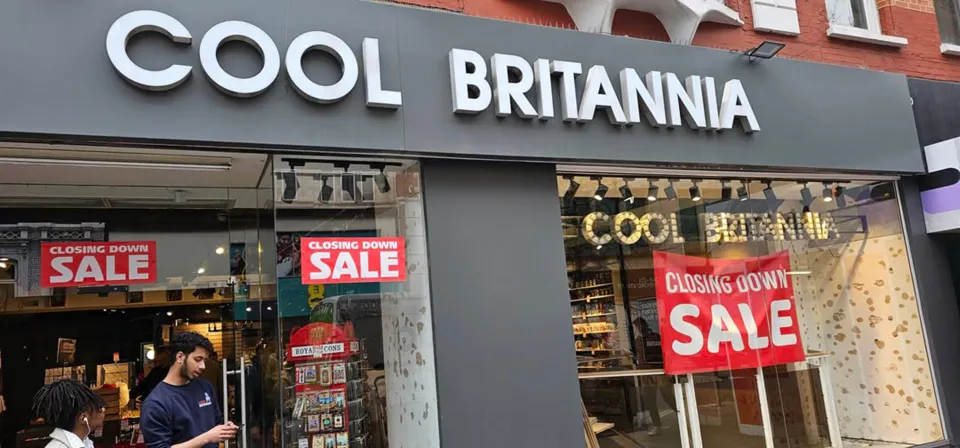The End of an Era for Cool Britannia
A well-known souvenir retailer, Cool Britannia, is preparing to close its doors on Oxford Street, London, one of the most iconic shopping destinations in the UK. The announcement came unexpectedly, not from the company itself, but from a loyal customer who noticed the “Closing Down Sale” signs in the store windows. This revelation, shared on Facebook, struck a nerve with locals and tourists alike.
Cool Britannia has long been a staple for tourists looking for British-themed memorabilia. Its central London location made it a go-to for Union Jack merchandise, London Bus models, and Beatles souvenirs. The store’s closure marks another shift in the changing landscape of the British retail scene.
What Is Cool Britannia?
A Brand of British Nostalgia
Cool Britannia isn’t just one store—it operates multiple gift shops across the UK. While its Oxford Street branch may be the most famous, the company also runs:
- Majestic Gift (near Buckingham Palace)
- Fancy That Of London (adjacent to the British Museum)
- Great Scot in Edinburgh
- Branches in Liverpool, Oxford, Canterbury, and Kent
Each location has its own flair. For instance, the Liverpool store sells Beatles memorabilia, while the Edinburgh store emphasizes Scottish-themed items. Yet, despite its popularity, the chain is beginning to feel the financial strain facing many retailers.
The Decline of Oxford Street
Retail Struggles Amid Economic Pressures
Cool Britannia is not the only store under pressure. Oxford Street, one of Europe’s busiest retail destinations, has been hit hard by declining footfall, inflation, and shifting consumer habits. According to data from analytics group CoStar, over 2% of retail space on Oxford Street is currently vacant.
While this is technically the lowest vacancy rate since 2017, it belies a deeper issue. Many flagship stores, including Zara, River Island, and Urban Outfitters, are reportedly considering closures or relocations due to looming renovations and increased rental costs.
The Park House Exodus
Several retailers share a prominent building on Oxford Street known as Park House. These include:
- Zara
- Urban Outfitters
- River Island
- Swarovski
- Bershka
- Life Pharmacy
- Pandora
Planning documents from Westminster City Council suggest that all seven may not renew their leases. Although Pandora has stated that no final decision has been made, the trend is worrying.
What’s Driving Store Closures?
Rising Costs of Employment and Operations
The retail industry is facing mounting financial pressures. The British Retail Consortium has warned that changes to employer National Insurance Contributions (NICs) will cost the sector an estimated £2.3 billion. Businesses are also grappling with increased utility bills, rent hikes, and supply chain disruptions.
Consumer Price Hikes
According to the British Chambers of Commerce, more than half of UK businesses plan to raise prices in the coming months. A survey of 4,800 companies revealed that:
- 55% expect to increase prices by April 2025
- 75% cite employment costs as their top concern
These rising costs are not just affecting businesses; they are being passed onto consumers, further reducing foot traffic in brick-and-mortar stores.
The Bigger Picture: UK Retail in Crisis
Store Closures on the Rise
Research by the Centre for Retail Research (CRR) paints a grim picture. In 2024 alone:
- 13,000 stores closed
- A 28% increase from 2023
CRR director Professor Joshua Bamfield warned that 2025 could be even worse, with up to 17,350 retail sites potentially shutting down.
“Although the outcomes for store closures overall were not as poor as in 2020 or 2022, they are still disconcerting, with worse set to come in 2025,” he said.
Job Losses on the Horizon
Professor Bamfield also predicted that as many as 202,000 retail jobs could be lost in 2025, a number that may surpass the pandemic’s peak in 2020. This decline is being driven by two factors:
- Increased costs of running stores
- Reduced consumer spending power
Microsoft Leaves Oxford Street
A Shift to Digital
Adding to Oxford Street’s woes, Microsoft announced it would end its lease early and shut down its massive flagship store to focus on digital growth. The tech giant explained that it routinely reviews its physical presence to align with market demands.
A Microsoft spokesperson stated: “We regularly review our locations and our workforce to ensure we are aligning to market opportunities and make changes to meet the demands of the business.”
What Does This Mean for the Future of Oxford Street?
A Call for Urban Revitalization
With major brands pulling out and independent stores struggling to survive, many are calling for a revamp of Oxford Street’s retail strategy. Proposals include:
- Encouraging pop-up shops and local businesses
- Reducing commercial rent
- Improving infrastructure and transport links
Revitalizing Oxford Street could help keep footfall high while fostering a more diverse retail mix.
The Cultural Impact
More Than Just Shops
Oxford Street has always been more than a shopping district. It’s a cultural and historical landmark. The closure of stores like Cool Britannia reflects broader societal shifts—from how people shop to how cities evolve post-pandemic.
Looking Ahead
Will We See a Turnaround?
While 2025 looks challenging, retail experts remain cautiously optimistic. With the right policy decisions, economic support, and business innovations, Oxford Street and UK high streets could find new life.
Whether through experiential retail, e-commerce integration, or urban redevelopment, change is inevitable. The closure of Cool Britannia may be a symbol of the times, but it could also mark the beginning of a new chapter for one of the world’s most iconic retail strips.
For now, the “closing down sale” signs in Oxford Street windows are a sobering reminder of the retail sector’s ongoing evolution.







